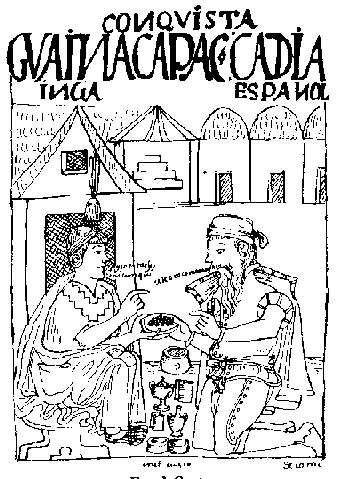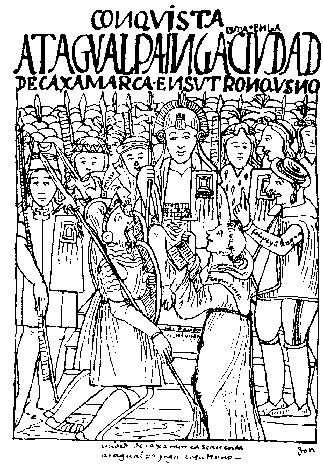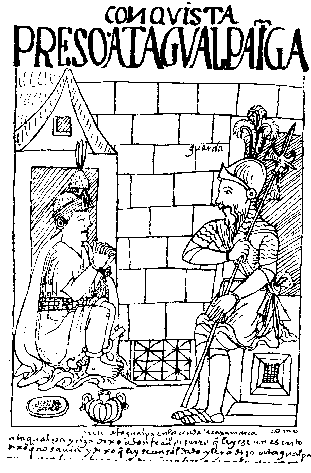 [p. 369]
[p. 369]Translator's note: The following is an early translation
that I did back around 1990 of a short
extract from The First New Chronicle and Good Government,
a huge manuscript written and illustrated by the indigenous (Quechua-speaking)
self-taught writer Felipe Guaman Poma de Ayala.
Between 2004 and 2006, I completed a much more thorough abridgment and translation
of Guaman Poma's masterpiece, based on considerably more research into Andean society
and language than I had under my belt in 1990. This translation in now being published by
Hackett Publishing under the title The First New Chronicle and Book of Good
Government, Abridged. (Click
here for the Hackett web page,
and
here for the Amazon page for the new translation, which should be out in November 2006.)
Guaman Poma began writing his masterpiece in the early 1600s, probably around 1608, and he completed
it in 1615-1616, when he claimed to be "80 years old" (that is to say, "very old") but was more likely
in his mid-60s. In 800 pages of text and 400
full-page drawings, he gives an account of the history of the world and of Peru
through the time of the conquest, followed by a close description
on the state of government and society in Peru under Spanish occupation in the early 1600s.
The selection presented here covers some of the better-known episodes of the conquest.
Guaman Poma (or Waman Puma, "Hawk Puma") was probably born around
1550, so he could not have witnessed the events in the early conquest
himself. Instead, he was a voracious reader of the chronicles
composed by Spanish conquerors and others. In these selections
he reinterprets the events as written by the Spanish from an Andean
point of view. The page numbers below refer to those in the original
manuscript. I have added almost all the punctuation.
For a short introduction to Guaman Poma, see the article at: http://marauder.millersv.edu/~columbus/data/art/ADORNO01.ART.
In 2001, the Royal Library of Denmark, where the original manuscript is preserved, published a remarkable digital edition of the text with a full color digital facsimile on their web site. You can consult the digital manuscript, which was edited by Rolena Adorno and Ivan Boserup, at: http://www.kb.dk/elib/mss/poma/index-en.htm.
-- David Frye, University of Michigan
From Jerusalem the apostle of Jesus Christ discovered it; the lord Saint Bartholomew went out to this land and returned during the time when the Inca Cinche Roca ruled only Cuzco and part of Collao.
And later, when Boniface IX was Pope, the Napolese pontifice, later, the road of the sea was discovered, in the year 1493. When the Spaniard Alexander VI was Pope, and the Emperor of Rome was Maximilian, and the Queen of Spain was Doña Juana, the Pacific Ocean became known, seven hundred leagues, to Paraguay and to the Indies. And there was news throughout Castile and Rome of how the New World had been found: for so the men of Castile called it.
This land was in the highest altitude, thus they called it Indies. This means land in the day; this is why they gave it the name Land In Day, In Dies, not because the natives were called Indians: from Indies they got Indians. This same land is higher than all Castile and the other lands of the world. The first word was New World -- this is the title and true name that it has -- and they are called Natives. And thus the new-come Spaniards call them Indians, even now they call them so, and they err. Just as the Spaniards are all in common called Spaniards -- wira cocha --, so the Indians: each group has its names: Castile, Rome.
 [p. 369]
[p. 369]Guayna Capac, Inca:
"Cay curitacho micunqui?" (Do you eat this gold?)
-- Candia, Spaniard:
"Este oro comemos." (We eat this gold.)
The companion of Columbus died and left his papers to his companion, to this same Columbus. And Candia reported in Castile that they had hit land in Santa. By signs they said that the first men had landed and that they wore very long beards and that they were shrouded, like corpses: this was the report that they gave to the Inca Guayna Capac in Cuzco. Then he had them carry him on a litter by messenger so that the Inca could see the new comer and the new-come Spaniard see the Inca, and they spoke by signs. And he asked the Spaniard what was it that he ate; he responded in the Spanish language and by directing signs at him that he ate gold and silver. And so he gave him a lot of gold dust and silver and gold utensils. With all this he ordered him to turn back again with the messenger to the port of Santa. When he arrived, they told him that his companion had died and so Candia left for Spain with his gold and silver and riches.
On how Candia arrived with the riches in Spain, with all he had brought, and proclaimed about the land and its riches. He said that the people wore clothes and shoes all of gold and silver and that they walked on floors of gold and silver and that on their heads and in their hands they carried gold and silver. He said this because of the dress that they wear to dance the taqui dances which the Indians do with clothes of silver and gold, golden blouses, cacro, chipana, canipo, culqui wayta, topos. And he said that there were small camels, speaking of the local sheep [llamas and alpacas].
With this news and greed and announcement of gold and silver came people. These kidnapped and Indian, Guanca Bilca, later named Felipe, and they brought him along as an interpreter to the conquest of this kingdom. And the captains and the soldiers arrived very happy; they had no gold; they yearned to arrive for their greed of gold and silver.
[p. 372] Don Francisco Pizarro and Don Diego de Almagro, the
two Captains General, and the rest congregated: three hundred
and fifty soldiers. Throughout Castile there were great tumults;
it was daytime and nighttime between dreams. Everyone said: "The
Indies, the Indies, gold, silver, gold, silver from Peru."
Even musicians sang the ballad: "Indies, gold, silver."
...
Thus were the first men; they did not fear death with their
interest for gold and silver. Worse are the ones of this life,
the Spanish corregidores, priests, and encomenderos. With their
greed for gold and silver they go to hell.
...

[The figures in front of the Inka are labeled, left to right: Almago, Pizarro, Fray Vicente, and Felipe, Indian Interpreter.]
[p. 385]
And having arrived in majesty, surrounded by his captains with many more people, twice a hundred thousand Indians, in the city of Cajamarca, in the public plaza, in the middle of it, on his throne and seat, on the altar which is his, called the usno, sat the Inca Atagualpa.
And then Don Francisco Pizarro and Don Diego de Almagro began to tell him, through the interpreter Felipe the Indian Guanca Bilca, he told him he was the messenger and ambassador of a great lord and that he should be his friend and that he had come only for this. He responded very politely to what Don Francisco Pizarro had said and the interpreter Felipe the Indian translated. The Inca responded with majesty and said that it was true that, having come as a messenger from so distant a land, he believed it must be a great lord, but that he did not have to make friendship, as he too was a great lord in his kingdom.
After this response Fray Vicente entered with his own, carrying a cross in his right hand and a breviary in his left. And he told the Inca Atagualpa that he was also an ambassador and a messenger from another lord, a very great one, a friend of God, and that he should be his friend and that he should adore the cross and believe in the Gospel of God and not worship any thing, that al the rest was mere mockery. The Inca Atagualpa responded, saying that he had to worship no one but the Sun, who never dies, nor his wacas and gods, who are also in his law: that he did keep.
And the Inca asked Fray Vicente who had told him so. Fray Vicente responded that the Gospel had told him, the book. And Atagualpa said: "Give me the book, so that it will tell me." And so he gave it to him and he took it in his hands and began to look through the pages of the book. And the Inca said: "Well, why doesn't it tell me? The book doesn't even talk to me!" Speaking with great majesty, seated in his throne, the Inca Atagualpa threw the book down from his hands.
and said: "Here, knights, these heathen Indians are against our faith!" And Don Francisco Pizarro and Don Diego de Almagro for their own part shouted and said: "Out, knights, against these infidels who are against our Christianity, and for our Emperor and King let us have at them!"
And so then the knights began to fire their harquebuses and they went into the skirmish and the soldiers began to kill Indians like ants. And from the fright of the harquebuses and the noise of the horse bells and of the arms and from seeing for the first time men never before seen, from the plaza of Cajamarca being so full of Indians, the walls of the enclosure of the plaza of Cajamarca came falling down, and people were killed between them. From being squeezed and being stepped on and trampled by the horses, many people died, so many Indians they could not be counted.
On the Spanish side five people died, of their own will: for no Indian dared, astonished as they were by the fright. They say that the five dead Spaniards were also found among the dead Indians; they must have been knocked senseless like the Indians, they must have been trampled by their own knights.
And so Don Francisco Pizarro and Don Diego de Almagro did take the Inca Atagualpa prisoner. They carried him from his throne without wounding him and he was imprisoned under custody and guard of Spaniards together with Don Francisco Pizarro. He was left very sad and disconsolate and dispossessed of his majesty, sitting on the ground, his throne and kingdom gone.

[The armored Spaniard is labeled guarda, guard.]
[This translation © 1999 by David Frye]